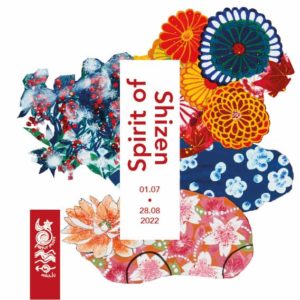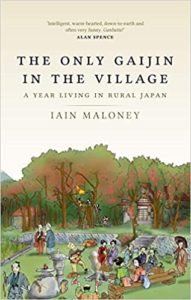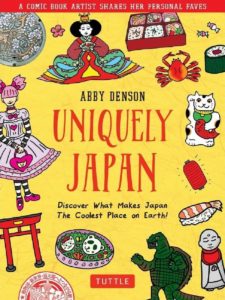Podcast host Amy Chavez talks to Robert Weis, curator of Luxembourg’s National Museum of Natural History’s upcoming exhibit, “Spirit of Shizen – The Nature of Japan Through its 72 Seasons” running from July 1 to August 31, 2022. An accompanying catalogue, in the form of an anthology, is also available featuring essays on Japan’s seasons.

Ep. Show Notes:
Amy starts off the show asking Robert Weis, a paleontologist, how he ended up curating the exhibition “Spirit of Shizen – The Nature of Japan through its 72 Seasons.” Weis explains his childhood fascination with fossils, his work at the museum, and his love for Japan. He says Mark Hovane, a Kyoto-based garden designer, was an adviser to the exhibition.
Amy expounds upon the meaning of “72-microseasons” as outlined in Mark Hovane’s essay of the same title included in the museum catalogue/anthology.
While some Japanese arts have obvious links to nature, such as to Ikebana flower arrangement, bonsai, gardens or cherry blossom viewing, Weis explains, other links may not be so obvious such as those in haiku poetry, Japanese sweets, or even the passing of time. These tie-ins to the seasons will come to the surface during the exhibit via workshops, demonstrations and a publication that focuses on Japanese culture and nature.
Workshops include a Miksang contemporary photography workshop with John Einerson, a calligraphy session by Japanese artist Rie Takeda, an exploration into the tea ceremony with Bruce Hamana and a workshop on the seasons as related to Zen, presented by French Buddhist nun and author Kankyo Tannier. A movie, produced by Felicity Tillack especially for the exhibition, will delve into the seasons of Kyoto and a gastronomic event coordinated with a local Japanese restaurant will inform the role of the seasons in Japanese cuisine. Visitors can enjoy a mock tea-house with tatami mats, or enjoy tea in the museum’s garden.
“Spirit of Shizen” (shizen means ‘nature’ in Japanese), also offers an accompanying catalouge/anthology of essays penned by prominent writers on Japan (read our review). The publication will be available on site at the Museum Store or you can purchase it online.
Here is a rundown of the authors and contents of the publication, which is divided into four parts, with Pico Iyer penning an introductory essay for each section.
“Spirit of Shizen” Anthology
Table of Contents
AUTUMN – Radiant wistfulness, by Pico Iyer
Momiji-gari – Tracking Down the Colored Leaves, by Rebecca Otowa
A late autumn walk in Nara, by Robert Weis
Naturally Attuned to the Seasons, by Edward Levinson
The Japanese 72 micro-seasons, by Mark Hovane
WINTER – Blue invigoration, by Pico Iyer
First winter in Ohara, by Patrick Colgan
Ontakesan – Seasonal elements of a sacred Japanese mountain, by Jann Williams
Kigo: Seasonal Words and Seasonality in Haiku, by Kawaharada Mayumi
Nature is Culture, by Sébastien Raizer
SPRING – Pink-and-white Flutter, by Pico Iyer
Petals on a wet black bough, by Amanda Huggins
Sakura, by Naoko Abe
Seasons of the Seto Inland Sea, by Amy Chavez (read an excerpt)
The Beauty of Japanese Gardens, by Yuri Ugaya
SUMMER – Festivals in the Sultry Nights, by Pico Iyer
The Message in the Garden, by Marc Peter Keane
Awareness of the Seasons in the Tea ceremony (Chanoyu), by Bruce Hamana
Mosses for the Ages, by Karen Lee Tawarayama
Notes on Ikebana, by Mark Hovane
Tsuyu – Between the sheets, by Edward J. Taylor
Note: Weis informs that there are no coronavirus restrictions right now for visiting Luxembourg or the museum.
Lastly, at the end of the show, Amy asks Weiss what his favorite books on Japan are:
The Lady and the Monk: Four Seasons in Kyoto, by Pico Iyer
South of the Border, West of the Sun, by Haruki Murakami
The Japanese Chronicles, by Nicolas Bouvier
About Robert Weis
Robert Weis is the author of over 30 scientific publications about Jurassic fossils. He has nourished a deep interest in Eastern Asian cultures, and especially Japan, since his childhood. He practices Zen meditation and the art of Bonsai and is especially interested in Japanese garden culture. Accounts on his Japanese travels can be found on his blog theroutetokyoto.com. He is the curator of the exhibition “Spirit of Shizen – the Nature of Japan through 72 seasons,” to be held at the Luxembourg Natural History Museum during summer 2022. He is also a travel writer for Luxembourg’s travel magazine “DIARIES OF.” His book Rocklines – a geopoetic journey across the Minett Unesco Biosphere, co-authored with Italian geopoet Davide S. Sapienza, will be on release in July 2022.
The Books on Asia Podcast is sponsored by Stone Bridge Press. Check out their books on Japan at www.stonebridge.com.
Your podcast host is Amy Chavez, author of Amy’s Guide to Best Behavior in Japan, and The Widow, the Priest and the Octopus Hunter: Discovering a Lost Way of Life on a Secluded Japanese Island.
Don’t miss out on upcoming episodes with Asia’s best authors and translators by subscribing to the Books on Asia podcast.










